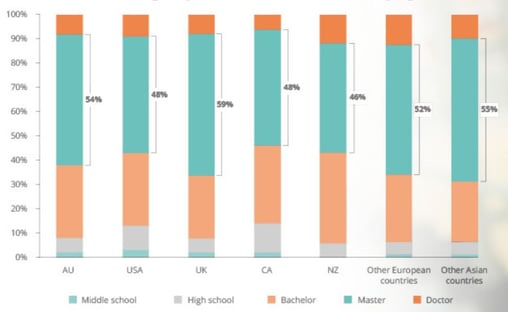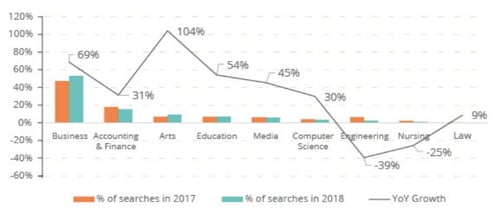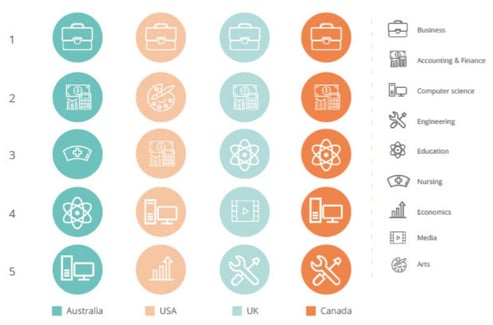When targeting Chinese international students, it’s of course vital to know what programs are of most interest to them. While some findings – like the popularity of Business degrees – are perhaps not so surprising, others – like the surging popularity of Liberal Arts programs, or the low level of influence peers have over students’ decisions – may defy expectations.
Level of education sought
Master’s degrees are by far the most sought-after qualification, with around half of Chinese international students undertaking Master’s programs. Bachelor degrees are also commonly sought, with around a quarter of students applying for these. They are slightly less popular in the UK, however, likely due to the high cost of their undergraduate programs.
Level of education sought by Chinese students when studying overseas, 2018

That being said, we’re seeing a significant increase in searches for bachelor’s degrees, with search volumes up in the most popular destinations. In UK, search volumes are up 77%; in US, they are up 69%; in Canada, they are up 64%; and in Australia, they are up 33%. We’re also seeing an increasing interest in secondary schools in all major destinations. In Canada, search volumes are up 55%; in the UK and Australia, they are up 29%; and in the US, they are up 27%.
Popular fields of study
It will likely come as no surprise that Business remains the most popular field of study sought by Chinese international students, with 53% of students looking for information about qualifications in this field in 2018, up from 47% the year before. The overall number of searches for queries related to this field grew by 69% year on year, an increase in demand that is mainly driven by searches for Business qualification in the US and the UK, while search demand for the same subject in Canada and Australia remains relatively flat.
Accounting and Finance also continue to be popular (16% of search traffic), followed by the Arts (10%).
Popular fields of study searched for by Chinese looking for information on studying overseas, 2017 & 2018

Interestingly, though, the Arts are showing the highest year-on-year growth rate (104%) for search terms related to this subject. Having said that this increase in demand is predominantly driven by searches for Arts education in the US and there has been very little change for the same search terms for the other destinations. This heightened interest is perhaps indicative of a changing attitude towards an Arts education, which was once viewed in China as less valuable than “hard” subjects like Science and Engineering. Now, the soft skills that such an education cultivates – like creativity, the ability to innovate, adaptability, collaboration and communication – are starting to be seen as crucial ingredients for success in a fast-changing, globalised world.
While universities in China are beginning to implement Arts programs, these are still very much in experimental phases. Students interested in undertaking Arts programs will therefore still be looking very much towards programs in international institutions in the next few years. Even though still popular, the field of Engineering has experienced the sharpest drop in demand with overall search volume dropping 39% from 2017 to 2018.
While the overall trend for this subject is declining for the US and Canada, demand for Engineering studies in Australia has dropped by a whopping 83% while interest for Engineering degrees in the UK has increased by 153%, albeit starting from a very low base.
Comparison of top 5 study majors being searched online for key destinations by searched volume, 2018

Main considerations when selecting a field of study
Chinese students are quite practical when it comes to selecting a field of study, with 53% of them citing future employment prospects as a deciding factor. Passion, however, is also a crucial factor, with 59% of students citing personal interest as a driving force in their selection (though this figure has fallen slightly since 2017). These two factors are certainly something marketers should consider when designing campaigns or crafting messaging.
It is also interesting to note that since 2017, more students are paying attention to acceptance rates and course difficulty, reflecting a growing pragmatism – Chinese students don’t simply follow the crowd blindly, but rather make informed and rational choices.











